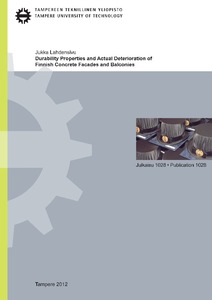Durability Properties and Actual Deterioration of Finnish Concrete Facades and Balconies
Lahdensivu, Jukka (2012)
Lahdensivu, Jukka
Tampere University of Technology
2012
Rakennetun ympäristön tiedekunta - Faculty of Built Environment
This publication is copyrighted. You may download, display and print it for Your own personal use. Commercial use is prohibited.
Julkaisun pysyvä osoite on
https://urn.fi/URN:ISBN:978-952-15-2823-1
https://urn.fi/URN:ISBN:978-952-15-2823-1
Tiivistelmä
Finnish multi-storey residential buildings have been built of precast concrete panels since the 1960’s. Half of these buildings, which for the most part are located in suburbs, were built in the fairly short period 1960-1979. The durability properties and repair needs of existing concrete facades and balconies are key factors contributing to the technical performance of the built environment and the owners’ economical decisions.
The general objective of this research was to study the factors that have actually had an impact on the service life, occurrence and progress of deterioration in existing concrete facades and balconies.
The research was based on condition investigation data from existing concrete buildings and measured weather data. The research material consisted of a database on the material properties and deterioration of existing Finnish concrete facade panels and balconies built between 1960 and 1996, and weather observations since 1961 made by the Finnish Meteorological Institute (FMI).
According to the research results, the durability properties of concrete structures are generally quite inadequate both as concerns reinforcement corrosion and frost resistance of concrete. Facade panels generally have only few areas where reinforcement cover depths are small, but they are significant in terms of the economy of cementitious patch repairs. Exposed aggregate, clinker tile and unpainted form finish concrete facades and balcony side panels have the poorest frost resistance. The poor frost resistance of balcony side panels may be considered a significant factor that limits the service life of the entire stock of precast concrete balconies since the side panels are load-bearing structures which cannot be replaced without demolishing the entire balcony structure. The durability properties of concrete structures have improved, especially since the 1980’s, as more attention has been paid to the durability of concrete structures e.g. by preparing durability guidelines.
The research results indicate that despite the generally quite poor durability properties of concrete facades and balconies, the concrete structures have suffered remarkably little far advanced and extensive corrosion and frost damage. The corrosion damage is almost entirely due to the carbonation of concrete. As concrete carbonises, corrosion occurs first in reinforcements closest to the outer surface. Local frost damage in facade elements typically occurs in the upper corners of buildings and at the edges of panels. Local frost damage in balconies typically takes place in the upper sections and especially the front edges of side panels. Visible frost damage clearly correlates with the frost resistance of concrete. The facade surface types and balcony elements that have small areas of inadequate frost resistance naturally suffer less frost damage.
The research results show that the stress on concrete structures from rain and sleet has a crucial effect on the initiation and propagation speed of damage. The amount of rain and sleet and prevailing wind directions during them are thus a quite clear cause of quicker deterioration in the coastal area than inland, and for the lesser corrosion and frost damage of concrete on northern to eastern facades of buildings compared to the southern to western facades.
The general objective of this research was to study the factors that have actually had an impact on the service life, occurrence and progress of deterioration in existing concrete facades and balconies.
The research was based on condition investigation data from existing concrete buildings and measured weather data. The research material consisted of a database on the material properties and deterioration of existing Finnish concrete facade panels and balconies built between 1960 and 1996, and weather observations since 1961 made by the Finnish Meteorological Institute (FMI).
According to the research results, the durability properties of concrete structures are generally quite inadequate both as concerns reinforcement corrosion and frost resistance of concrete. Facade panels generally have only few areas where reinforcement cover depths are small, but they are significant in terms of the economy of cementitious patch repairs. Exposed aggregate, clinker tile and unpainted form finish concrete facades and balcony side panels have the poorest frost resistance. The poor frost resistance of balcony side panels may be considered a significant factor that limits the service life of the entire stock of precast concrete balconies since the side panels are load-bearing structures which cannot be replaced without demolishing the entire balcony structure. The durability properties of concrete structures have improved, especially since the 1980’s, as more attention has been paid to the durability of concrete structures e.g. by preparing durability guidelines.
The research results indicate that despite the generally quite poor durability properties of concrete facades and balconies, the concrete structures have suffered remarkably little far advanced and extensive corrosion and frost damage. The corrosion damage is almost entirely due to the carbonation of concrete. As concrete carbonises, corrosion occurs first in reinforcements closest to the outer surface. Local frost damage in facade elements typically occurs in the upper corners of buildings and at the edges of panels. Local frost damage in balconies typically takes place in the upper sections and especially the front edges of side panels. Visible frost damage clearly correlates with the frost resistance of concrete. The facade surface types and balcony elements that have small areas of inadequate frost resistance naturally suffer less frost damage.
The research results show that the stress on concrete structures from rain and sleet has a crucial effect on the initiation and propagation speed of damage. The amount of rain and sleet and prevailing wind directions during them are thus a quite clear cause of quicker deterioration in the coastal area than inland, and for the lesser corrosion and frost damage of concrete on northern to eastern facades of buildings compared to the southern to western facades.
Kokoelmat
- Väitöskirjat [4768]
